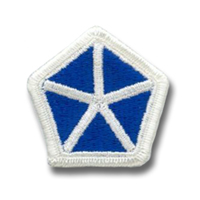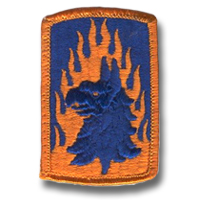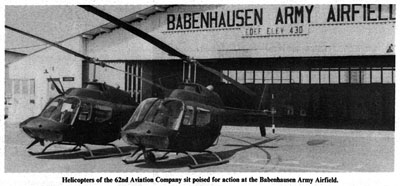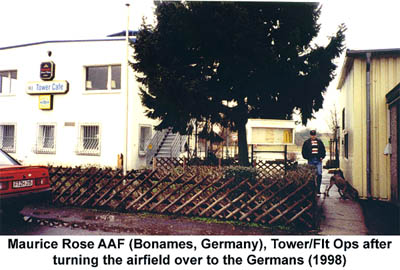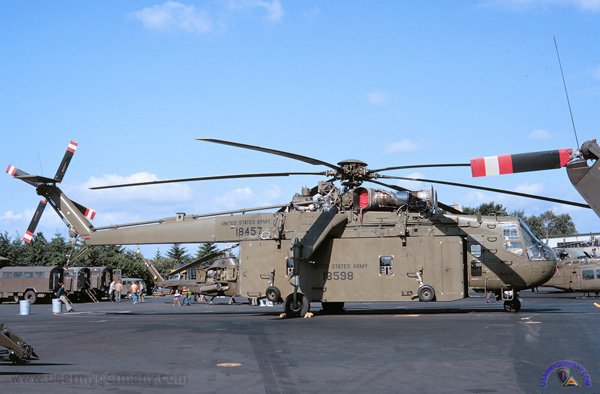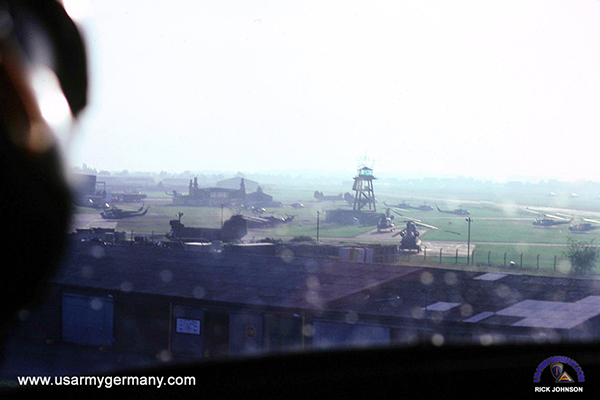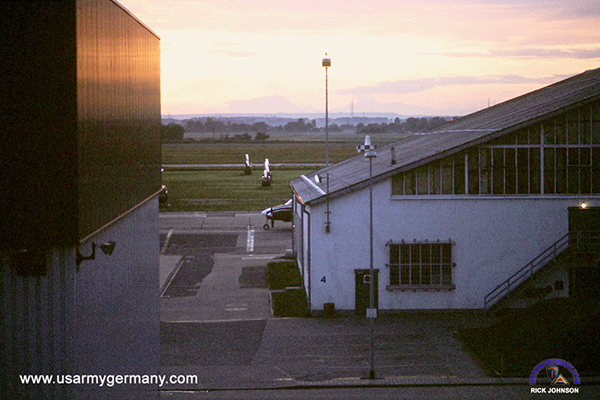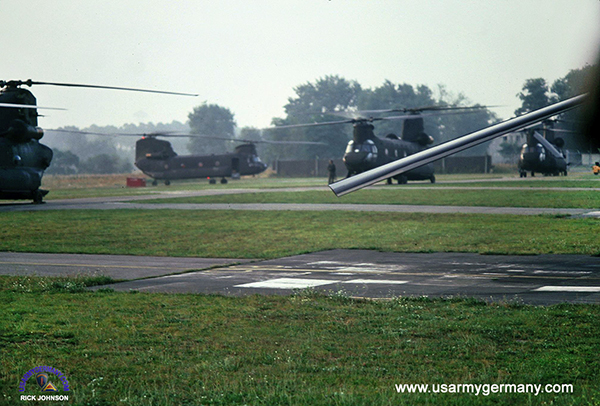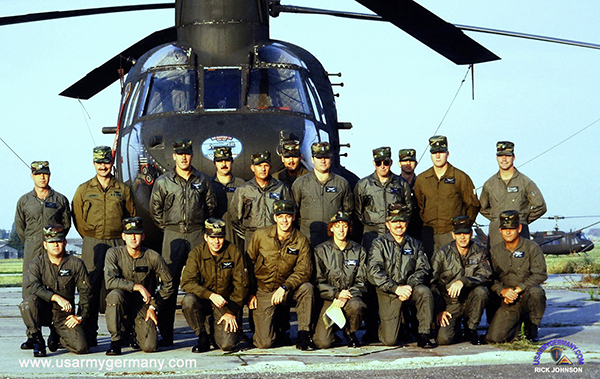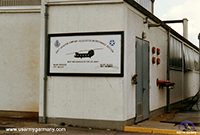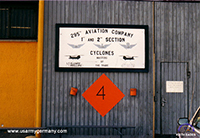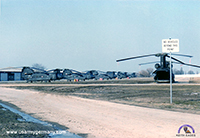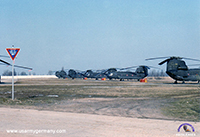| If you do
NOT see the Table of Contents frame to the left of this page, then
Click here to open 'USArmyGermany' frameset |
||||||||||||||||||||||||||||||
|
11th
Aviation Battalion |
||||||||||||||||||||||||||||||
|
|
||||||||||||||||||||||||||||||
|
||||||||||||||||||||||||||||||
|
|
||||||||||||||||||||||||||||||
| 11th Avn Battalion History | ||||||||||||||||||||||||||||||
| 1972 - 1987 | ||||||||||||||||||||||||||||||
|
(Source:
Historical information provided by the V Corps PAO, early 1980s)
|
||||||||||||||||||||||||||||||
|
11th
Aviation Battalion (Combat)
Stationed at Fliegerhorst Kaserne near Hanau, the 11th Aviation Battalion (Combat) is the air wing of V Corps. (Webmaster Note: this information probably dated back to the early 1970s. In the early 1980s, HHC, 11th Aviation Bn was located in Frankfurt.) Organized August 23, 1965, at Fort Benning, Georgia, the 11th was assigned the mission of tactical air movement of troops, supplies and equipment in a combat zone. The 11th was moved to Vietnam in October 1965, participating in 13 campaigns, earling the Valorous Unit Citation. In September 1972, the 11th was reactivated in West Germany to support V Corps. To perform this mission, the 11th has a varied inventory of aircraft available, including the Huey UH-1H, the OH-58A light observation helicopter, the COBRA AH-1H attack helicopter, the CHINOOK CH-47, and the UH-60 Blackhawk. In addition to its major mission, the 11th is also responsible for maintenance and control of Maurice Rose Army Airfield, Bonames, Frankfurt. |
||||||||||||||||||||||||||||||
|
|
||||||||||||||||||||||||||||||
|
In
October 1987, under Army-wide restructuring, the the 11th Aviation
Battalion became the 5th Battalion, 158th Aviation
Regiment.
|
||||||||||||||||||||||||||||||
| If you have more
information on the history or organization of the 11th Aviation Battalion,
please contact me |
||||||||||||||||||||||||||||||
|
|
||||||||||||||||||||||||||||||
| (Source: STARS & STRIPES Archives - Photo of the Day feature) | ||||||||||||||||||||||||||||||
| Some great action photos of a 295th Avn Co Chinook (CH-47) in 1981. | ||||||||||||||||||||||||||||||
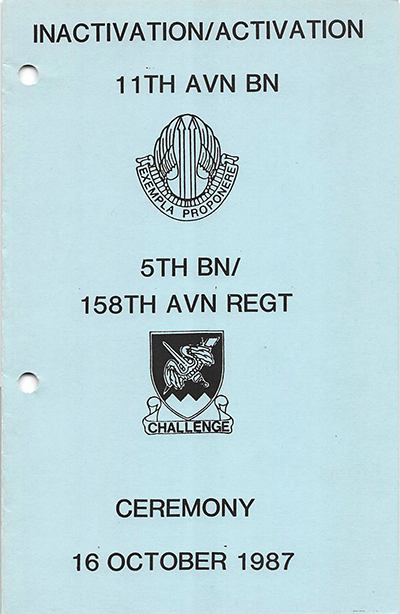 |
||||||||||||||||||||||||||||||
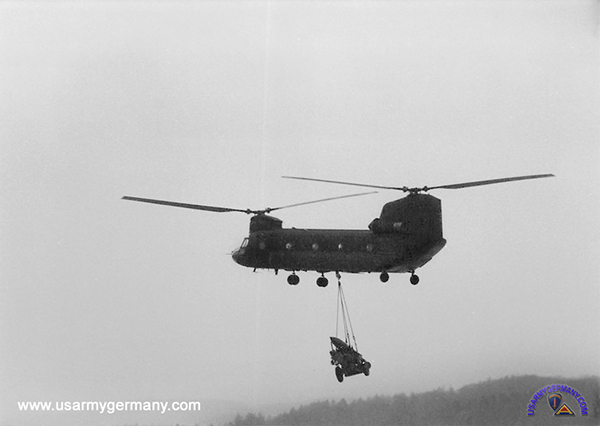 The 62nd Avn Co performed many interesting missions: photo taken from a 62nd Avn UH-1 shows a CH-47 CHINOOK of the 42nd FA Bde carrying a sling-loaded LANCE missile during a CARAVAN GUARD exercise. The UH-1 was transporting the Security Team (Richard Gillogly) |
||||||||||||||||||||||||||||||
| 1986 | ||||||||||||||||||||||||||||||
| (Source: Email from Richard Gillogly) | ||||||||||||||||||||||||||||||
| I was assigned to the 62nd Aviation Company at Maurice Rose Army Heliport in June 1986. I served with 62nd Avn Co and then the 5-158 AVN REGT. I was at both EDEN (Maurice Rose - 1986-92) and EDOU (Wiesbaden Air Base - 1992-94) from 1986 until August 1994. 62nd AVCO had the HQ section and the barracks in Bldg 517 on Drake Kaserne. We had the 3rd & 4th Floor of Bldg 517 and shared the 1st Floor with 3AD. My wife was in 3rd AD on Drake Edwards. (To see some of Richard's great photos of Maurice Rose AHP from the late 1980s, click here.) |
||||||||||||||||||||||||||||||
|
|
||||||||||||||||||||||||||||||
| 5th Bn, 158th Aviation History | ||||||||||||||||||||||||||||||
| 1987 - present | ||||||||||||||||||||||||||||||
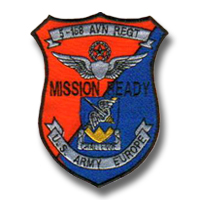 5th Bn, 158th Aviation Patch
5th Bn, 158th Aviation Patch |
||||||||||||||||||||||||||||||
|
(Source:
5th Bn, 158th Avn official website)
|
||||||||||||||||||||||||||||||
| Headquarters
Company, 158th Aviation Battalion,
nicknamed the "Fighting Knights", reorganized on 18 September 1987
at Giebelstadt Army Airfield (GAAF) in Giebelstadt, Germany and was
designated as Headquarters and Headquarters Company, 5th Battalion,
158th Aviation Regiment. The line company elements of the battalion,
A/5-158th and E/5-158th, are located at Wiesbaden Air Base (WAB) in
Wiesbaden, Germany. The latest company to join the 5-158th Aviation
Regiment is B/5-158th, which was activated on 16 October 1998 in Aviano,
Italy. The activation of C/5-158th at WAB, projected for January 2000,
will complete the Army's Doctrinal template of the Mission Ready Battalion.
C/158th Aviation Regiment, nicknamed the "Blue Stars" since 16 November 1965, originally began as H Company, 2nd Battalion, and 47th Quartermaster Truck Regiment in 1936. After years of being deactivated, it was recalled to active duty in 1956 as the 93rd Transportation Company. It received a unit designation of the 48th Aviation Company (Airmobile) Light on 5 July 1965 in Fort Benning, Georgia. In August 1972 the Blue Stars deployed from Vietnam to Katterbach, Germany and were attached to the 223rd Aviation Battalion, VII Corps at Ansbach Army Airfield. In October 1984 the unit was reassigned to the 11th Aviation Battalion, 12th Aviation Group, V Corps, and stationed in Wiesbaden, Germany. In 1987 the unit was redesignated from the 48th Aviation Company to C/7-158th Aviation Regiment. In 1992 the unit moved from Wiesbaden to Giebelstadt where it was assigned to the 5-158th Aviation Regiment, 12th Brigade, V Corps. D/158th Aviation Regiment, nicknamed the "War Eagles", was originally the 203rd Aviation Company (Utility Airplane), founded on 23 September 1942 as the 2048th Quartermaster Truck Company, Aviation and was activated at Baer Field, Indiana. The unit was redesignated on 7 March 1967 as the 203rd Aviation Company and officially activated on 1 April 1967 at Fort Sill, Oklahoma. On 16 August 1982, the 203rd located at Peden Barracks in Wertheim, Germany, joined the 11th Aviation Battalion, 12th Aviation Group, and V Corps. On 16 October 1984, the 203rd was reassigned to VII Corps and joined the 223rd Aviation Battalion, 11th Aviation Group. The unit remained the 203rd Aviation Company until 17 November 1987 when it redesignated as C/6-159th Aviation Regiment. On 16 August 1992, with the draw down of VII Corps, C/6-159th Aviation Regiment and was reassigned to V Corps as part of the 5-158th Aviation Regiment. The War Eagles moved to GAAF on 15 December 1992. F/159th Aviation Regiment, nicknamed "Big Windy" since 5 August 1969, was activated on 17 March 1966 as the 180th Aviation Company at Fort Benning, Georgia. In March of 1973, Big Windy departed from a seven-year tour in Vietnam for Europe. In November 1987, the 180th Aviation Company was redesignated to A/5-159th Aviation Regiment. In June of 1993 Alpha Company relocated from Dolan Barracks, Schwäbisch Hall to GAAF. Over the following years, the company gathered remnants of the now deactivated "Geronimo", "Cyclone" and "Centurion". The Centurion's deactivation in 1997 gave Big Windy the distinction as the only CH-47 medium lift unit in the European Theater. In August 1996 the company came under control of the Mission Ready Battalion, 5-158th Aviation Regiment. The Mission Ready organization is an Aviation Task Force built around the 5-158th Aviation Regiment. The Mission Ready Task Force is currently the largest and most diverse in the United States Army. The task force has a total of 62 helicopters, 798 soldiers and 229 wheeled vehicles and is dispersed throughout three geographical locations. |
||||||||||||||||||||||||||||||
| If you have more information on the history or organization of the 5/158th Avn, please contact me. | ||||||||||||||||||||||||||||||
|
|
||||||||||||||||||||||||||||||
| 62nd Avn Co / B Co, 5th Bn, 158th Avn | ||||||||||||||||||||||||||||||
| (Source: 62nd Combat Aviation Company website, accessed 12/14/2012) | ||||||||||||||||||||||||||||||
| After redeployment from Vietnam, the 62nd Aviation Comany “Royal Coachman” was activated in West Germany in September 1973 as part of the 11th Aviation Battalion (Combat) to support V Corps. Initially the 62nd was stationed at Fliegerhorst Kaserne near Hanau, with detachments throughout central and southern West Germany, including Babenhausen and Giessen Army Airfields. Often the arrival of detachments of the Royal Coachman meant the reactivation of airfields and the reintroduction of aviation access to the supported elements. In the late 70s, the 62nd and Battalion HQ relocated to Maurice Rose Army Airfield (MRAAF) outside of Bonames, a northern suburb of Frankfurt/Main. At it’s peak in the 1980s, the 62nd consisted of 21 UH-1H and 20 OH-58 helicopters and two fixed wing (C-12 and U-21). Overtime, the Royal Coachmen adopted the call sign of “BOSS”. This call sign signified the importance of the 62nd Aviation Company mission – “TO FLY THE BOSS”. The unit also earned a reputation as one of USAREUR's safest, most competent and professional aviation companies, truly “Masters of the Trade”. As a troop lift capable unit the 62nd provided dedicated air transport to the Corps and its direct support units and trained for combat missions consistent with the unit’s history. The units helicopter mission support varied widely to include day and night VIP transport, paradrops, rappelling, stabo operations, air assault and nuclear surety security. The two fixed wing aircraft provided broader area transport. In October 1987, the 62nd’s platoons were redesignated as individual line companies. For the newly activated 5th Battalion, 159th Aviation, the 62nd Command Flight Platoon (UH-1) became A Company, 5 – 158th (VIP) and B Company 5 – 158th (Lift). The 62nd Observation Platoon (OH-58) became C Company 5 – 158th (VIP) and D Company 5 – 158th (Target and Acquisition). The 62nd Maintenance Platoon became E Company 5 – 158th Aviation. Final closure of Maurice Rose Army Airfield came on August 18, 1992 when the 5th Bn, 158th Aviation, formerly the 62nd Aviation Company, relocated to Giebelstadt Army Airfield. |
||||||||||||||||||||||||||||||
| 1979 | ||||||||||||||||||||||||||||||
| (Source: Harry Hayne, 62nd Avn Co, 1979-82) | ||||||||||||||||||||||||||||||
| I was stationed in Frankfurt a/M Federal Republic of Germany from October, 1979 until December, 1982. I was assigned to the 62nd Aviation Co., 11 th Aviation Bn.
During that time we worked out of Maurice Rose Army Airfield in Frankfurt/Bonames. When I first arrived, the following companies were a part of the 11th Avn. Bn. Out of Frankfurt/Bonames were HHC and the 62nd Avn. Co. and out in Hanau was the 173rd Avn Co. During my time there we added the 295th Avn Co. out of Mannheim. We were flying at that time OH-58’s, UH-1’s with the 62nd and the 173rd while the 295th flew CH-47’s. We also had a fixed wing aircraft or two assigned to the 11th but they were not kept at Maurice Rose. At this time I was a 51-M Firefighter assigned to the 62nd Avn. Co. We had 1 fire truck, starting with a 530-B and then a 530-C. For most of the time we worked out of a converted communications trailer at the base of the tower. During this time I was an E-5 Sergeant and was the Crash Rescue Chief for firefighting. We had anywhere from a total of 4-6 51-M firefighters assigned at any one time. I had forgotten about the EDEN identifier until I saw it mentioned in the article. Some of the more enterprising among us ordered t-shirts with the following: It had a picture of soldier in a hammock between 2 trees with the words Maurice Rose Army Airfield above the picture and The Garden of EDEN below the picture. In your picture captioned Maurice Rose AAF (1986) the white building served as both flight operations from the downstairs and as 62 Avn. Co headquarters on the 2nd floor (up the gray stairs you see in the middle of the picture). It was also during this time that the 295th had one of their CH-47’s go down during an air show with a large loss of life; this was a sad time for all of us assigned to the 11th Avn Bn. |
||||||||||||||||||||||||||||||
| 1982 | ||||||||||||||||||||||||||||||
| (Source: ABOUT TOWN, May 5, 1982) | ||||||||||||||||||||||||||||||
| Royal Coachman
now call Babenhausen home by David Alberti BABENHAUSEN - The Royal Coachmen of the 62nd Aviation Company have landed here, reactivating the Babenhausen Army Airfield and setting up shop as a permanent member of the Darmstadt Military Community. |
||||||||||||||||||||||||||||||
 |
||||||||||||||||||||||||||||||
|
||||||||||||||||||||||||||||||
| Crowley said
he expects the airfield here to "really come to life over the next
few months. The Section here may see an addition of two to four more
aircraft and perhaps one UH-1 utility helicopter to supplement our
observation ships. Over the summer, there are plans to use our airfield
as a site for night training flights for helicopters from the 62nd's
home base at Maurice Rose Army Airfield in Frankfurt." Crowley said
the increased activity and noise during the summer's night flights
may cause some inconvenience to the residents of the kaserne here. At present, the Babenhausen Aviation section consists of two pilots and four ground support personnel. Crowley said that setting up and maintaining a fully operational airfield with such a small staff is "difficult at times. Everyone here in theSection wears a lot of different hats and carries many responsibilities. But, I feel our people are the best and we've gotten good support from Col. August Cianciolo, commander of the 41st Brigade, and from the other units here, which has made our move-in much easier." |
||||||||||||||||||||||||||||||
|
|
||||||||||||||||||||||||||||||
|
(Source:
Email from David Blackburn, 62nd Avn Co, 1984-87)
|
||||||||||||||||||||||||||||||
|
||||||||||||||||||||||||||||||
|
The
11th was a subordinate unit of the 12th Aviation
Group (also headquartered in Wiesbaden Airbase). The
Group commander was COL Golden.
|
||||||||||||||||||||||||||||||
| 1987 | ||||||||||||||||||||||||||||||
| (Source: Email from Ted Pucylowski, B Co, 5th Bn, 158th Avn, 1987-90) | ||||||||||||||||||||||||||||||
As a 2LT, I was initially given orders to the 62nd Aviation Company upon completing flight school in October 1987. When I reported to When I left the Battalion in August of 1990, they were preparing to deploy to the Gulf region in support of Desert Shield/Desert Storm. I keep reading on all of these websites about us being in Giebelstadt, but we were not. I served as a Platoon Leader for 2nd Platoon, Bravo Company, 5/158th; as the Battalion S-4; and finally as the Assistant S-3 from November 1987 until August 1990. I hope this helps. |
||||||||||||||||||||||||||||||
|
|
||||||||||||||||||||||||||||||
| 173rd Avn Co (Air Asslt) | ||||||||||||||||||||||||||||||
| 1972 | ||||||||||||||||||||||||||||||
| (Source: Email from Myron Foxworth) | ||||||||||||||||||||||||||||||
| Within less than 30 days after my 18th birthday I joined the Army on Dec 4th,1972. I was sent to Germany on May 12th, 1972 arriving at Frankfurt's 21st Replacement Center at Michael Barracks Frankfurt-Hoechst. The 21st Replacement Center assigned me to the V Corps 18th Battalion 350 Avn Co (Airmobile) at Fliegerhorst Kaserne just outside of Hanau, Germany. My MOS was 63B20 Light Wheel Vehcile Mechanic. In September 1972 my Battalion was deactivated and the colors and equipment of the 11th Aviation Battalion from Vietnam was added to our inventory. My Battlattion change to the 11th Avn and my company was redesignated as the 173rd Aviation Company (Air Assault). Before the change we mostly had "D and "C" model slicks and a few Cobra gunships. The change increased our gunships from, it seemed like almost none, to a ton over night. Germany was great experience for me. I remember the good time at the Plantation club on 97 General Hospital in Frankfurt, partying in Mannheim, K-Town, Wiesbaden, the great times during Fasching Season, and a host of other things like the drag racing held at Fliegerhorst Kaserne's airstrip during the summer. There were two cars (Wild Thing and Cherry II) that I remember to this today. The funny thing was, some time two seated fixed wing planes would come to land. The drag racing would stop just long enough for the plane to land and taxy off the runway. I could go on and on about my experiences in Germany but I am writting this to see if I could find some of my partners from that time like Sgt Price, Sgt Kelly, PFC Shaw, SP4 Caves, John Carter from Washington, DC, Charles Barnes from Washington, DC, Myron and Otha Govan from Portland OR, Sgt Robindon from Washington State, Sgt Bobby Gains, Sgt Smith, Captian Borrows, and Doc my home boy from North Augusta, SC. There are many more like PFC Gray from Houston, TX. SP4 Word out of Viginia. Maybe I will get some hits from this post and get a chance to reconnect with some old friends. Most of which served in my unit, the 2nd 75th Field Artillery, 62 Avn Co, 30th Trans, 125th Maint, and 73rd MI Fixed Wing Mohaw Unit. |
||||||||||||||||||||||||||||||
| 1976 | ||||||||||||||||||||||||||||||
| (Source: Email from David Hag) | ||||||||||||||||||||||||||||||
|
Why is there an absence of aviation history during the 1970-1980 time period?
I was assigned to the 173rd Aviation Company (Air Assault), 1976-1980.
Shortly after arriving we moved out of the hangar next door to the 205th AVIM facility -- to next hangar over towards base operations. Our barracks was the third building to the south from the NCO club....almost directly aligned to the "quad." The unit had 23 UH-1's.
Directly behind the barracks was "Sherwood Forest", as the theme for the 173rd was taken from Robin Hood, as we were nicknamed....the "Robinhoods" which was carried over from the units conception in Vietnam, as found in the unit's Heraldry. |
||||||||||||||||||||||||||||||
| (Source: Email from Rick Loucks) | ||||||||||||||||||||||||||||||
| I was stationed in Hanau at Fliegerhorst Kaserne from 1976-1979. When I arrived, I was with V Corps assigned to the 334th Attack (Hel.) Co. I think the HQ was 11th Grp in Schwaebish Hall. The "G" model Cobras were there at that time and later got a few Mods and prods if I remember correctly. The Commanders' name I believe was Maj. Gary Ramage. Later, it seems (if my memory serves me right), the 173rd AHC took the place of the 334th. I was a Crew Chief, with the "Robin Hoods" on a UH-1. I believe after a while, there were UH-1's from 62nd Avn Co out of Maurice Rose there. I remember that down at the end of the airfield, there was a contract maintenance company called LSI. They were installing the M-56 Subsystem on our Acft. I remember the enjoyable Drag Races on Sundays there on the runway. Kinda like a "Taste of Home". I recently went to a web site of what the old Airfield there looks like now that it has been given back to the FRG. Kinda disheartening to see all the weeds and how it is grown over since then. I had my family with me after a while and lived in the Cardwell Hsg area off Lamboystrasse St in Hanau. I have to say that It was one of my more memorable times in the Army. I spent 24 yrs as a member. I enjoyed reading about the old Units on this site. Thanks for the walk down memory lane. (Webmaster note: based on information provided by Jim Sprinkle, the 334th Attack Helicopter Company deployed from Fort Knox, Ky. to Hanau AAF, West Germany, in mid-November 1972. On September 1978 they were re-designated C Company, 503rd Aviation Battalion.) |
||||||||||||||||||||||||||||||
| 295th Aviation Company (Heavy Helicopter) | ||||||||||||||||||||||||||||||
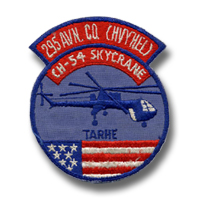 295th Aviation Company - TARHE Patch 295th Aviation Company - TARHE Patch 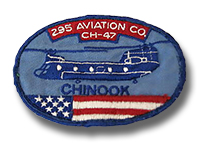 295th Aviation Company - CHINOOK Patch 295th Aviation Company - CHINOOK Patch |
||||||||||||||||||||||||||||||
| Finthen Army Airfield | ||||||||||||||||||||||||||||||
| 1969 | ||||||||||||||||||||||||||||||
| (Source: STARS & STRIPES, May 12, 1969) | ||||||||||||||||||||||||||||||
| The advance party of the 295th Aviation Company (Heavy Helicopter) and its support unit, the 326th Transportation Detachment, recently arrived at Finthen AAF, Germany, from Fort Sill, Okla. The advance party is tasked with preparing the unit's new home at Finthen for the arrival of the main body. The company is attached to the 15th Cbt Avn Gp in Schwaebisch Hall. In connection with the assignment of the CH-54A unit to USAREUR, the 90th Medium Helicopter Company in Hanau is being inactivated. (That unit's CH-37 Mohave helicopters - at least most of them - will be shipped back to the US.) The arrival of the CH-54 unit improves the aviation posture of USAREUR by increasing its lift capability - the Skycrane can carry up to 10 tons. The 295th is the first (and will remain the only) CH-54 unit assigned to USAREUR. |
||||||||||||||||||||||||||||||
| 1971 | ||||||||||||||||||||||||||||||
| (Source: STARS & STRIPES, April 18, 1971) | ||||||||||||||||||||||||||||||
| The CH-54A helicopter is now nicknamed the "Flying Crane." Before it was known as the "Skycrane." CO of the 295th is Lt Col Lee P. Biggs. He came with the unit from Fort Sill in 1969. For short hauls, the CH-54A can hoist up to 20,000 pounds. Normally, however, the helicopter transports cargo in the 12-18,000 pound range. Solid cargo is hauled in nets, on pallets or in pods. Pods are lightweight aluminum containers that attaches to the belly of the Cranes. Liquid cargo is transported in 500-gallon bladders. Methods of transport 1. A cable and winch assembly allows for a single-point pickup of heavy objects - such as a downed aircraft - from areas with limited access. he CH-54 can carry up to 10 tons using this method. 2. A four-point pickup (using four hooks along the sides of the fuselage which can grip a cargo in nets or straps) is used to haul bulky containers. 3. The third method is the pod. The detachable pod is 6' 6" high, 8' 10" wide and 27' 5" long. The 3,000-pound container can be pre-loaded (detached from the chopper) or remain attached to the helicopter for on- and off-loading at the pickup point. The pod can carry approximately 11,3000 pounds of cargo, 45 passengers or 24 litters. The pod can also be sued as a mobile command post that can be shifted to other locations on short notice. Unit Missions In the past year, the 295th has been involved primarily in aircraft recovery (about 50 missions) and a daily parts run between the Pirmasens Army Depot and several aviation maintenance units (at Mannheim, Kiztingen and Hanau). Parts and supplies are picked up at the army depot and dropped of at the designated support units. Parts and eauipment destined for depot repair or turn-in are then loaded onto the C-54 and delivered to the depot the next day. |
||||||||||||||||||||||||||||||
| The 326th Trans Det was inactivated in 1973 (?) and the detachment's personnel (and mission) were assiged to the 295th. | ||||||||||||||||||||||||||||||
| (Source: Henk Scharringa, the Netherlands, European Aviation Historical Society) | ||||||||||||||||||||||||||||||
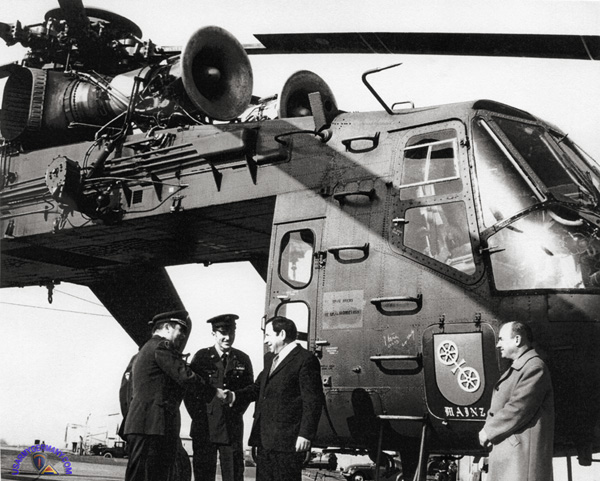 CH-54A TARHE (68-18454) christened "MAINZ" (Wolfgang Balzer via Ingo Schlösser). German official shaking hands with unidentified Army officer is Jockel Fuchs, Oberbürgermeister of Mainz. |
||||||||||||||||||||||||||||||
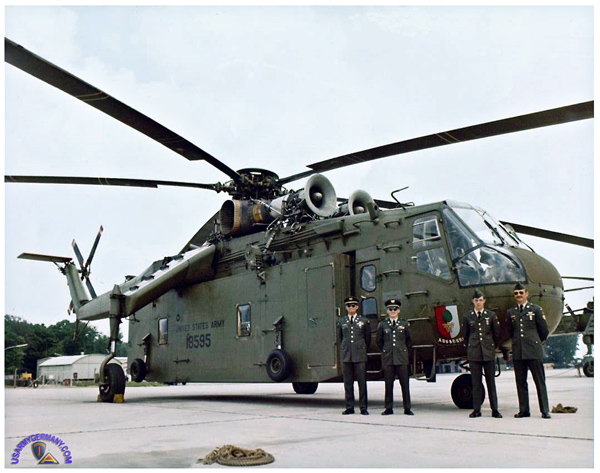 CH-54 TARHE christened "AUGSBURG" at Finthen AAF (Augsburg Municipal Archives). |
||||||||||||||||||||||||||||||
| 1973 | ||||||||||||||||||||||||||||||
| (Source: STARS & STRIPES, Nov 21, 1973) | ||||||||||||||||||||||||||||||
| All of the Skycrane's of the 295th Avn Co in Finthen, Germany, have been named after German cities. In a recent (Nov 14) ceremony at Finthen AAF, aircraft 68-18461 was christened after the city of Heidelberg. (So far, only five aircraft have been officially dedicated.) The lord mayor of Heidelberg, Herr Reinhold Xundel, poured a bottle of champagne over the Heidelberg crest displayed on the helicopter's cockpit door. The naming of the aircraft after German cities is an effort to bring about a better understanding among the local population. Webmaster Note: According to Chuck Roger's website, the following names were applied to the CH-54's at Finthen **:
|
||||||||||||||||||||||||||||||
| ** Aircraft 68-18452 crashed in 1970 and most likely never was named after one of the German cities. | ||||||||||||||||||||||||||||||
| 1976 | ||||||||||||||||||||||||||||||
| (Source: US Army Aviation Digest, November 1976) | ||||||||||||||||||||||||||||||
| In the Spring of 1967, at Henry Post Field, Ft. Sill, OK, the 295th Aviation Company (Heavy Helicopter) began a most impressive era in the history of Army aviation. It was to be an era of the CH-54 Skycrane and the people associated with them. Activated in April of that year, the company started its building in personnel, equipment and the new CH-54. Its first mission was to organize and train CH-54 elements deploying to the Republic of Vietnam. Interestingly, the first award won by this fine aviation unit was the Award for Outstanding Marching Unit of the Artillery Aviation Command. Its first permanent commander was Major Vernon L. Sawvell. Support and training for CH-54 platoons deploying to Vietnam continued into 1968, with Major Ronald A. Jones commanding. This fledgling company also was now providing support to the Artillery and Missile School and conducting its own CH-54 aircraft transition course. The unit also was called upon to perform other missions within the United States, challenging them still further. Towards the end of the year the unit was notified it, too, was to be deployed. To top the year off, two CH-54s and their crews were sent to Europe for participation in Reforger I. Vigorous unit training for deployment became the mandate in January 1969, with emphasis on quality maintenance training. While still providing helicopters and crews throughout the United States, the 295th Aviation Company achieved outstanding ratings on FTX and the ATT. Deployment came in May to Finthen Army Airfield, Germany, under the command of Major James E.Rogers. The 295th had joined the 15th Aviation Group (now the 11th Aviation Group). With much of Finthen AAF facilities still under construction, field maintenance had to be set up to support the helicopters. The first assigned mission came quickly, calling for flight demonstrations for the services, VIPs, and the German press in order to acquaint them with USAREUR's newest capability. Local area orientation for all Aviators was completed by 15 June and the company was mission ready. Throughout Europe missions began to develop calling for aircraft recoveries, precision placement of bridge sections, movement of heavy equipment, troop hauls and airshows. Letter after letter was received at the company attesting to its outstanding service, professionalism and international goodwill. General James H. Polk, commanding general of USAREUR, visited the 295th and praised them for their progress since their arrival in Germany. After only 4 1/2 months in Germany, the company had successfully passed its AGI, while still maintaining a high aircraft availability. The 295th Aviation Company had set a new pace for USAREUR aviation units. The pace has continued through the years. The 295th routinely fulfilled the mission of providing airlift for troops and heavy equipment. The diverse and professionally demanding missions became the order of the day. With their faithful Skycrane, they built dikes in the Netherlands, set large air-conditioning units on top of tall buildings, sling-loaded fighter aircraft in Spain, recovered crash damaged aircraft of many types throughout Europe, moved Sno-Cat plows to mountain tops, set towers in place to build ski lifts, mounted large TV antennas to provide television service to U.S. Forces in Germany, and also were used as an airborne fire fighting vehicle dumping thousands of gallons of water to extinguish forest fires. The unit also contributed immeasurably to better relations with their German neighbors. A unique idea was nurtured and developed wherein each of the Skycranes was formally christened and named after selected cities throughout Germany. Recognition of these events still continues with the exchange of greetings with the Lord Mayors during the Christmas season. These accomplishments have resulted in the selection of the 295th Aviation Company and/or its supporting 326th Transportation Detachment for the coveted honor of USAREUR Aviation Unit of the Year in 1969, 1971, 1972 and again in 1974. They are justifiably proud of these achievements. Recently, the thrust has been directed toward survivability in a mid-intensity environment. To this end, the unit has been developing their skills in terrain flying techniques, low level both day and night. As a result, aircrews are prepared to meet the challenge of tonnorrow. Flying safety is always of foremost concern in any aviation unit and the 295th has avery enviable flying safety record. Since its activation in August 1967, it has only experienced one aircraft accident and that was in July 1970. The company has since flown nearly 12,000 accident-free hours and in July 1976 the company qualified for the new “Department of the Army Aviation Accident Prevention Award of Excellence” for achieving 72 months of accident-free flying. What have been the major contributing factors to the success of the 295th? One has been a love affair developed in the beginning between the people and the Skycranes. Maintainability and reliability have helped this unit to consistently provide outstanding service to support units. Second, the unique characteristics of the CH-54 have provided many unusual and professionally demanding missions that would otherwise have to be accomplished by other means. Finally, and most important, has been the attitude of the personnel. They live for the challenge of tomorrow. They are convinced that any mission can and will beaccomplished. “Can-do” is their byword. Moreover, they will do it professionally, safely and better. |
||||||||||||||||||||||||||||||
| Coleman Barracks, Sandhofen | ||||||||||||||||||||||||||||||
| 1977 | ||||||||||||||||||||||||||||||
| The 295th Aviation Company transitioned from the CH54's to CH-47 CHINOOKS after REFORGER 1977 and relocated from Finthen to Coleman Barracks in Sandhofen (Mannheim). Webmaster note: Some information that I found while doing research on Army Aviation topics, indicates that the 295th relocated to Mannheim in August 1977 and that it was then assigned to the 11th Aviation Battalion (Combat). Can anyone provide confirmation and/or more details? |
||||||||||||||||||||||||||||||
| (Source: MESSENGER, July 15, 1983 (Vol.11, No.13) REFORGER 1977 | ||||||||||||||||||||||||||||||
| HISTORY: the 295th Aviation Company was activated in 1967 at Ft Sill, OK. The unit originally flew the CH-54A Skycrane (Tarhee). The 295th received its first CH-47C Chinook in Sep 1976. After arriving in Germany, the unit flew out of Finthen AAF. In August 1977, the unit was relocated to Coleman AAF where it became part of the 11th Aviation Battalion (Cbt). |
||||||||||||||||||||||||||||||
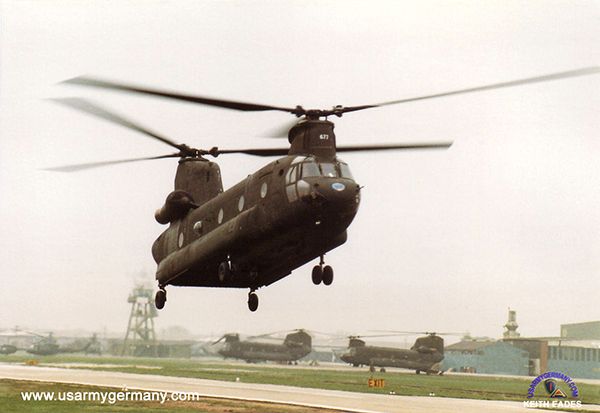 A CH-47 of the 295th Aviation Company taking off from Coleman AAF (Keith Eades) |
||||||||||||||||||||||||||||||
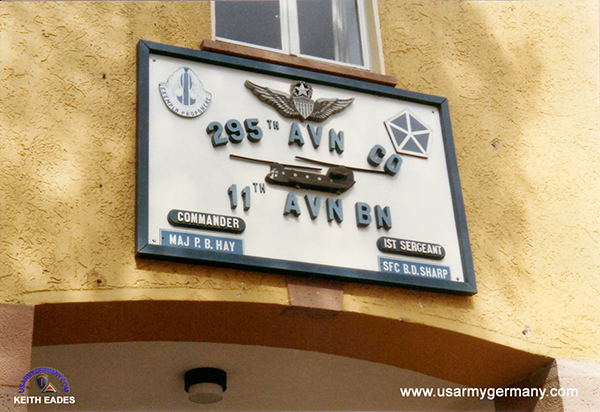 295th Avn Bn sign over the entrance to unit's barracks, Coleman Bks (Keith Eades) |
||||||||||||||||||||||||||||||
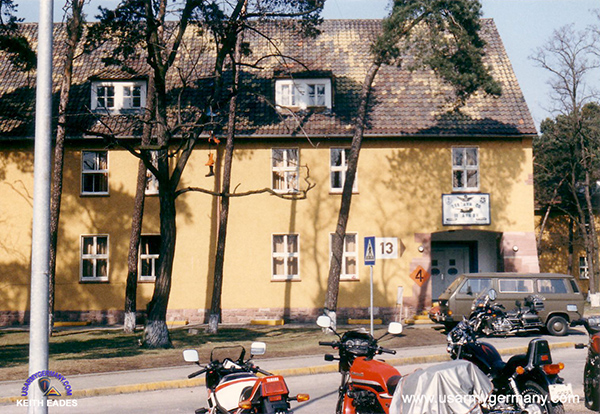 Bldg #13, Coleman Barracks, 295th Aviation Company (Keith Eades) |
||||||||||||||||||||||||||||||
| 1985 | ||||||||||||||||||||||||||||||
| (Source: Keith Eades, 295th Aviation (Cyclones) Mannheim, Germany - CH-47 Chinook FB) | ||||||||||||||||||||||||||||||
| I was stationed at Coleman Barracks from Jan 1985 - May 1987 and assigned to the 295th Aviation Company as a Crew Chief / Flight Engineer. | ||||||||||||||||||||||||||||||
|
||||||||||||||||||||||||||||||
| To see more photos submitted by Keith on the Coleman Army Airfield Page, click here. | ||||||||||||||||||||||||||||||
| Related Links: 66th Avn Co, Air Traffic Control, Germany, 1971-74 - Stephen Dayhuff's webpage with memories of his days as an air traffic controller with 11th Aviation Battalion Augmentation at Hanau AAF 295th Aviation Co (HH) - Another very good Army Aviation web site - the 295th served at Mainz-Finthen AAF and flew the CH-54A Sikorsky Skycrane Helicopter (TARHE) in the early 1970s. Chuck Rogers is the webmaster. 295th Aviation (Cyclones) Mannheim, Germany - CH-47 Chinook 62nd Aviation Company (Welcome to 62ndcacrc.com) - The 62nd Aviation "Royal Coachmen" Web Site (Vietnam, 1968-1973, and Germany, 1973-1987) |
||||||||||||||||||||||||||||||
